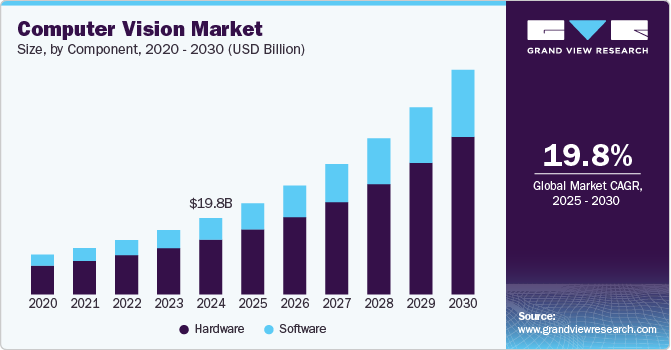Computer vision is defined as the field of AI that allows computers to see and interpret visual images, something that until now has been reserved for biological life forms.

Computer vision is, for example, deployed in the automobile industry. Not all automobile companies have the same approach, but some base their advanced driver assistance systems on vision, like Tesla (NASDAQ: TSLA). The cameras in Tesla’s vehicles “see” what a human driver is seeing, and interprets these images based on AI that’s running in the background.
Other automobile companies use LIDAR (light-based radar) systems to evaluate distances etc., but even Alphabet’s (NASDAQ: GOOG) Waymo uses vision-based systems for some tasks, such as identifying road signs.
While healthcare is a very different industry compared to the automobile industry, computer vision is generating major benefits there as well. Intuitive Surgical (NASDAQ: ISRG), which manufactures semi-robotic surgical systems, employs computer vision that helps surgeons detect items of note, for example.
Siemens Healthineers division manufactures healthcare imaging systems, and it’s adding more computer vision technology to help radiologists detect anomalies. GE Healthcare (NASDAQ: GEHC), a peer of Siemens Healthineers, is doing the same with its imaging systems.
In retail, tech giant Amazon (NASDAQ: AMZN) is working on checkout-free shopping systems that use computer vision to “scan” the items that the customer has bought. Louis Vuitton (NYSE: LVMUY), a luxury goods company, uses computer vision systems to track customers’ movements in their stores in order to optimize store layouts, advertising banners, and so on.
Consumer home products, such as Amazon’s Ring system or smart TVs, use computer vision as well, and in the defense and security industries, computer vision systems, e.g. from Palantir Technologies (NASDAQ: PLTR), are of use as well.
Set Your Sights on Computer Vision’s Future
Investors can benefit from the growth of computer vision in different ways. Investors could buy shares of companies that deploy computer vision systems, such as TSLA or ISRG, although these aren’t computer vision or AI pure plays.
Investors can also invest in the companies that power the computer vision MegaTrend from behind the scenes: This includes companies like NVIDIA (NASDAQ: NVDA), as its data center chips are essential for training and running the AI models that are needed for computer vision to work. Advanced Micro Devices (NASDAQ: AMD) is another chip company with significant data center exposure that will benefit from increased data center chip sales thanks to more and more AI models being deployed.
While Intel (NASDAQ: INTC) has been lagging in the data center chip space, relative to NVDA and AMD, its Mobileye unit is a major player in computer vision technology, primarily in automobile technology – as the technology is rolled out by more and more automobile companies, a specialized hardware supplier like Mobileye should benefit.
Investors can also choose among some of our top Artificial Intelligence picks to benefit from increased Artificial Intelligence usage computer vision.

